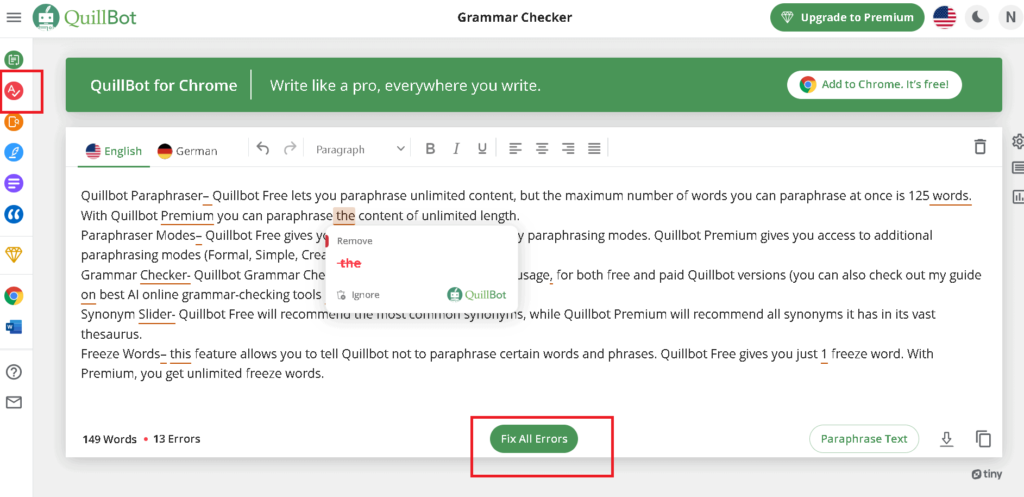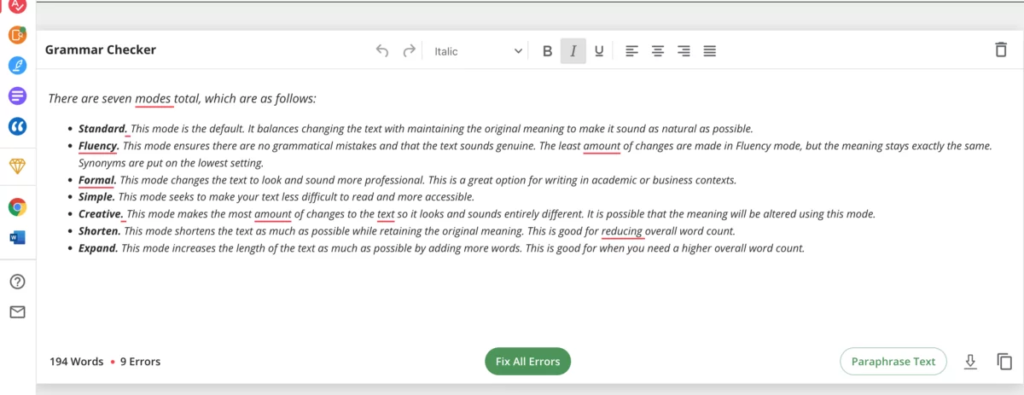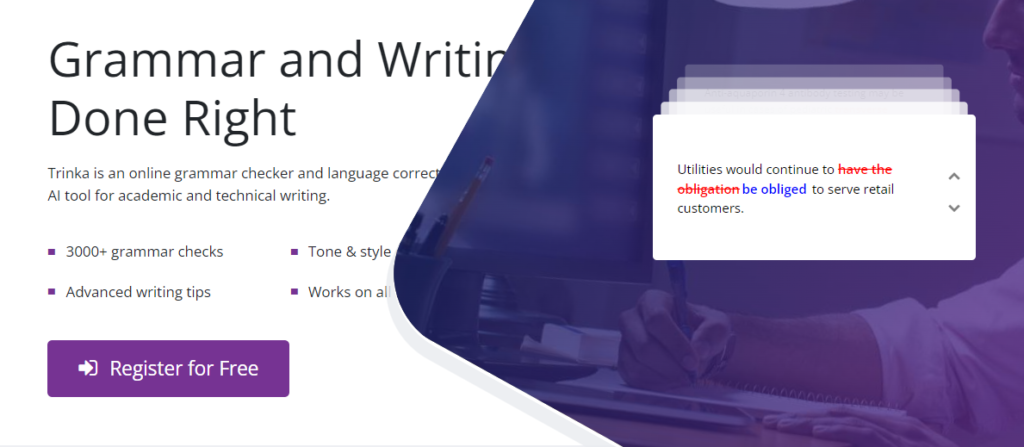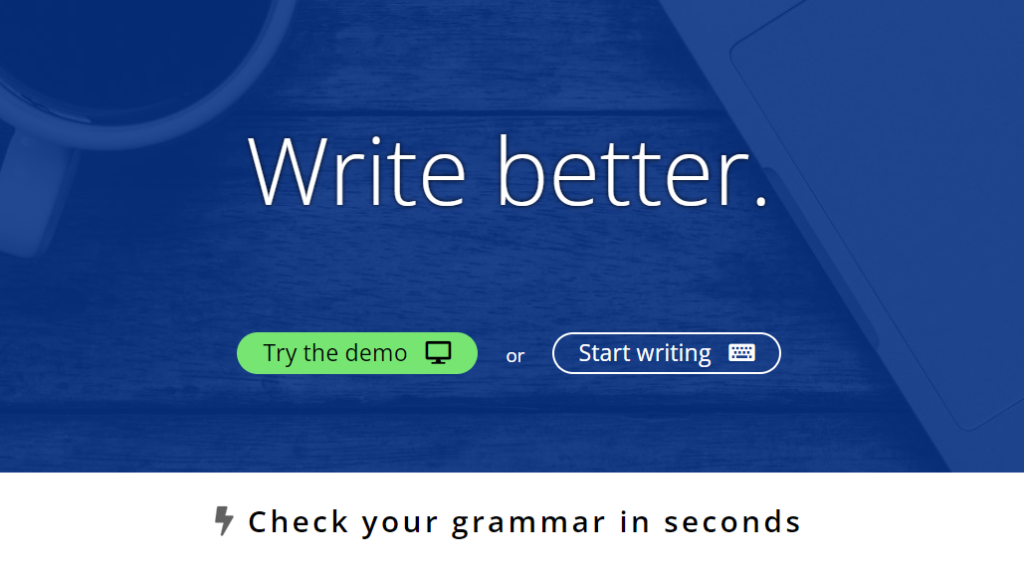Maintaining parallel structure in writing is crucial for grammatical correctness and readability. This entails repeating a consistent grammatical pattern within sentences or paragraphs, creating clarity and auditory appeal.
Identifying and correcting parallel structure errors can be challenging, but tools like QuillBot provide valuable assistance.
For example, if a sentence lists items without the same grammatical form, such as “I like swimming, to hike, and reading,” the tool highlights the lack of parallelism and suggests a correction like “I enjoy swimming, hiking, and reading.”
Practicing parallel structure is key to improving writing skills while ensuring clarity and readability.

| Tool ⭐ | Plans | Features | Accuracy |
|---|---|---|---|
| Quillbot | Free, Premium starts from $4/mo | Paraphrasing, grammar, summarizing, tone detection, citation, plagiarism checker, and more. | Excellent for parallelism |
The Top Parallel Structure Sentence Checker & Corrector: Best Free Online Tools
1. Quilllbot Rewriter & Grammar Parallelism Checker

QuillBot is an AI-powered writing assistant that offers a range of helpful features for anyone who wants to improve their writing.
One of the most useful tools it provides is the Parallel structure checker (The Grammar Checker).
QuillBot’s Parallel structure checker is a fantastic feature that helps users identify and correct any instances of parallelism that are missing or inconsistent in their writing.
It works by highlighting sentences that lack parallel structure and suggesting corrections that users can apply with just a few clicks.
Using QuillBot’s parallelism/grammar checker can help you enhance your writing skills significantly.
Not only will it make your text more aesthetically pleasing, but it will also improve its readability and overall impact.
In summary, QuillBot’s Parallel structure checker is an invaluable resource for anyone who wants to take their writing to the next level.
With this feature, you can easily improve the structure and coherence of your text, making it more engaging and effective.
So next time you use QuillBot, be sure to try out the Parallel structure/grammar checker, and take advantage of this pro tip to elevate your writing game!
Pro tip: Try using QuillBot’s rewriter feature to quickly paraphrase a new version of any text.
- Other features of Quillbot: grammar check, paraphrasing, summarizing, citation, plagiarism check, AI co-writing, translating, and Word, Chrome, and macOS integration.
2. Grammarly Checker

Grammarly is a popular online writing assistant that can help you with a variety of writing tasks, including checking for parallel structure errors.
The tool uses artificial intelligence to analyze your text and provide suggestions for improving your writing.
The parallel structure checker in Grammarly highlights any sentences that do not follow a parallel structure and provides suggestions for correcting the error.
Additionally, Grammarly offers a premium version that provides more detailed feedback on your writing and suggests more advanced corrections.
Pro Tip: Grammarly also offers a browser extension that can check your writing in real-time as you type in your web browser.
- Other features of Grammarly: plagiarism checker, citation, tone detection, doc analytics, and Chrome & Mobile integration.
3. Hemingway Editor

The Hemingway Editor is a web-based writing tool that helps you simplify your writing and make it more concise.
While it is primarily designed to help writers avoid wordiness, it also includes a parallel structure checker that highlights any instances of parallelism errors.
The tool offers suggestions for correcting the error and provides a readability score for your writing.
Pro Tip: The Hemingway Editor can be used for free online, but you can also purchase a desktop version for a one-time fee.
4. ProWritingAid

ProWritingAid is a comprehensive writing tool that can help you with everything from grammar and spelling to style and structure.
The parallel structure checker in ProWritingAid identifies any sentences or paragraphs that do not follow a parallel structure and provides suggestions for correcting the error.
The tool also includes a host of other features that can help you improve your writing, such as a contextual thesaurus, a grammar checker, and a style editor.
Pro Tip: ProWritingAid offers a free version that includes basic grammar and spelling checks, but you will need to purchase a premium subscription to access the parallel structure checker and other advanced features.
- Other features of ProWritingAid: include grammar check, tone check, plagiarism check, style editor, and over 20 writing reports.
5. Trinka AI

Trinka AI is a language and grammatical accuracy tool for academic and technical writing. It offers a free plan that provides access to all Trinka features, as well as a premium plan available for a fee.
6. Slick Write

Slick Write is a free online grammar checker and proofreader that can help you identify and correct errors in grammar, spelling, and parallel structure. It also provides suggestions for how to improve your writing style and clarity.
Comparison: Grammarly vs. QuillBot vs. Hemingway vs. ProWritingAid
In terms of parallel structure checker, Grammarly, QuillBot, Hemingway, and ProWritingAid are some of the popular writing tools available.
1. Quillbot Quick Review
QuillBot is a free tool that is dedicated to paraphrasing but also has features related to grammar checking.
Quillbot Plans & Pricing
Quillbot has two plans: Free and Premium.
- Free offers basic paraphrasing tools, while Premium has advanced features.
- Premium costs $9.95/month, $39.95/semi-annually (33% off), or $49.95/annually (58% off).
- All plans include plagiarism checker, tone detection, and paraphrasing history.
2. Grammarly Quick Review
Grammarly is primarily a grammar checker that can detect errors in parallel structure. It offers suggestions to correct the errors and provides explanations for why the changes are necessary.
Grammarly Plans & Pricing
Grammarly has free, premium, and business plans:
- Free plan includes basic writing suggestions and tone detection.
- Premium plan starts at $12.00 USD/month includes everything in the Free plan plus clarity, vocabulary, and tone improvements, full-sentence rewrites, word choice, tone suggestions, and citations.
- Business plan starts at $15.00 USD/member/month includes everything in the Premium plan plus features like style guide, snippets, brand tones, analytics dashboard, account roles and permissions, and SAML single sign-on.
- Grammar, spelling, and punctuation correction available in all plans.
- Volume discounts and discounts for educational institutions are available.
- Grammarly offers a range of tools, including desktop and mobile apps, browser extensions, and APIs.
3. Hemingway Editor Quick Review
Hemingway Editor doesn’t check for any grammar errors or spelling mistakes. However, it provides suggestions for passive voice, complex phrases, and hard-to-read sentences. It also highlights sentences with poor parallel structure.
Hemingway Plans & Pricing
The Hemingway Editor has both an online version and a desktop version.
The online version is free to use, and the creators have indicated that they intend to keep it this way.
The desktop version, Hemingway App, is available for a one-time payment of $19.99 for both Windows and Mac.
There are no monthly fees associated with the Hemingway Editor or App.
4. ProWritingAid Quick Review
ProWritingAid is a comprehensive editing tool that includes options for creative writing, business writing, and academic writing. It checks for grammar errors and style issues such as parallelism. It provides reports on variety, readability, passive voice, and other indicators of writing health.
ProWritingAid Plans & Pricing
ProWritingAid offers 3 plans, monthly, yearly, and lifetime:
- Including a monthly plan for $30,
- A yearly plan for $10 per month (billed as a lump sum of $120),
- And a lifetime plan for a one-time payment of $399.
Each plan includes varying levels of features and benefits, with the Premium plan offering unlimited word count, advanced style improvements, a custom style guide, and more.
Customers can also take advantage of a 14-day money-back guarantee and various discounts, such as a 20% discount for students.
Overall, ProWritingAid’s pricing structure aims to provide flexibility and value for users looking to improve their writing skills.
Accuracy
In terms of accuracy and effectiveness in detecting parallel structure errors, Grammarly and ProWritingAid are considered among the best tools available.
Both tools offer suggestions to correct the errors and provide explanations for why the changes are necessary.
However, ProWritingAid offers more in-depth reports to help strengthen your writing.
It is accurate for fiction writing and a good option for fiction writers who want to improve their work’s readability and style.
Comparison Table of Top Parallel Structure Checker & Corrector Tools
| Tool | Plans & Pricing | Features | Accuracy |
|---|---|---|---|
| Grammarly | Free, Premium $12/mo, Business $15/mo | Grammar, spelling, punctuation, tone detection | Excellent for parallel structure |
| Quillbot | Free, Premium starts from $9.95/mo | Paraphrasing, plagiarism checker, tone detection | Moderate |
| Hemingway Editor | Online (free), Desktop ($19.99) | Suggestions for passive voice, complex phrases, readability | Good for parallel structure |
| ProWritingAid | Monthly ($30), Yearly ($120), Lifetime ($399) | Grammar, style issues, unlimited word count | Excellent for parallel structure |
How to Check Parallel Structure for Sentences & Paragraphs Online Using Quillbot

Quillbot is an AI-powered writing assistant that can help check for parallel structure in your writing. Here are the steps to use Quillbot to check for parallel structure:
- Go an login to the Quillbot website.
- Select the “Grammar Checker” option from the menu at the top of the page.
- Copy and paste your text into the text box provided.
- Click on “Check Grammar”.
- Quillbot will analyze your text and highlight any instances of non-parallel structure.
- Review the highlighted sections and revise them as needed to ensure parallelism.
Quillbot’s grammar checker uses AI technology to identify grammatical errors, including issues with parallel structure, in your writing.
It compares your work against online and offline publications, finding parallel grammatical phrases and patterns.
Additionally, you can use other grammar check programs such as Grammarly to help you look for additional errors or style issues you overlooked.
How to Check for Parallel Structure Manually
To check for parallel structure, you can start by reading your sentence out loud.
Pay attention to the structure and forms used in each part of the sentence.
Look for instances where the structure or form used in one part is not the same as the others.
For example, consider the sentence: “I like to read books, watching movies, and going for walks.”
This sentence is lacking parallel structure because the structure of the first two activities (“like to read” and “watching movies”) is different from the third activity (“going for walks”).
To make this sentence parallel, you can change the structure of the third activity to match the first two: “I like to read books, watch movies, and go for walks.”
Using Grammarly & QuillBot‘s parallel structure checker is another effective way to check for parallelism in your writing.
The tools automatically detects and highlights any instances of parallelism that are lacking in your writing. It also suggests corrections to improve the structure and readability of your sentences.
Parallel Structure Check Steps Manually:
Here are some steps you can follow to check for parallel structure in your writing:
- Identify the elements that you want to make parallel. This could be a list of items, a series of actions, or any other similar structure.
- Look at the grammatical structure of each element in the list. Are they in the same tense? Do they use the same parts of speech (e.g. nouns, verbs, adjectives)?
- If any elements are not in the same grammatical structure, revise them to match the others.
- Check that the order of the elements is consistent throughout the list. If necessary, rearrange the elements to ensure they follow a consistent pattern.
- Read the entire sentence or paragraph to make sure that the parallel elements work together to convey your meaning effectively.
- If you’re still not sure if your writing is parallel, try reading it aloud or having someone else read it to you. This can help you identify any awkward or inconsistent phrasing that may need to be revised.
By following these steps, you can ensure that your writing is clear, concise, and easy to read, making it more effective in communicating your message to your audience.
Difference Between Parallel Structuring vs. Paraphrasing
Parallel structuring
Parallel structure is a writing technique that involves repeating a chosen grammatical form within a sentence, paragraph, or multiple paragraphs to create word patterns that readers can easily follow.
This technique adds clarity and balance to writing, particularly when comparing, coordinating, listing, or presenting ideas as stubs in a table.
To achieve parallel structure, the ideas being compared or presented need to have a similar grammatical structure (e.g., adjectives with adjectives, verbs with verbs, nouns with nouns).
Paraphrasing
On the other hand, paraphrasing is the act of rewording information in your own words while maintaining the original meaning.
A paraphrasing tool is a useful tool when you want to avoid plagiarism or simplify complex information for better understanding.
Paraphrasing is different from parallel structure because it focuses on rephrasing sentences rather than using a consistent grammatical form.
Here are the steps to achieve parallel structure:
- Identify the ideas being compared, coordinated, listed, or presented in a sentence, paragraph, or multiple paragraphs.
- Determine the grammatical form of the first idea (e.g., adjective + noun, verb + object).
- Repeat the same grammatical form with the other ideas being presented.
- Review the sentence, paragraph, or multiple paragraphs to ensure that all ideas are expressed using parallel grammatical forms.
Tool: you can use Grammarly to check parallelism automatically!
And here are the steps for paraphrasing:
- Identify the information you want to reword.
- Understand the original meaning of the information.
- Use synonyms and alternative phrasing to reword the information.
- Check that the rephrased information retains the original meaning.
Tool: you can use Quillbot to paraphrase, but also check grammar automatically!
FAQs – Q&A

What is a Parallel Sentence?
A parallel sentence is a sentence that has two or more similar ideas or actions that use the same grammatical pattern. In a parallel sentence, the ideas or actions are joined by a conjunction and are expressed in the same grammatical form.
This helps to create a sense of balance and coherence in the writing, and makes it easier for the reader to understand and follow the ideas being presented.
What is Sentence Structure and What Does it Look Like?
Sentence structure refers to the way that words, phrases, and clauses are arranged to form a complete sentence. In English, there are several different types of sentence structure, including simple, compound, complex, and compound-complex.
A simple sentence consists of a single independent clause, or a group of words that contains a subject and a verb and expresses a complete thought. For example: “The cat sat on the mat.”
A compound sentence consists of two or more independent clauses that are joined by a conjunction such as “and,” “or,” or “but.” For example: “The cat sat on the mat, but the dog slept on the couch.”
A complex sentence consists of an independent clause and one or more dependent clauses, or clauses that cannot stand alone as a complete sentence. A dependent clause is introduced by a subordinating conjunction such as “because,” “while,” or “although.” For example: “Although the cat sat on the mat, the dog slept on the couch.”
A compound-complex sentence consists of two or more independent clauses and one or more dependent clauses. For example: “The cat sat on the mat, but the dog slept on the couch because he was tired.”
What is Parallel Sentence Structure and What Does it Look Like?
Parallel sentence structure is an important aspect of effective writing. It involves using the same grammatical form for similar elements of meaning within a sentence or among sentences. When two or more ideas are parallel, they should be expressed in parallel grammatical form.
Single words should be balanced with single words, phrases with phrases, and clauses with clauses.
Here is an example of a sentence with parallel structure: “I like to run, swim, and bike.” In this sentence, all three phrases are in the same form (infinitive verbs) and are joined by the conjunction “and.”
On the other hand, here is an example of a sentence without parallel structure: “I like to run, swim, and to bike.”
In this sentence, the phrase “to bike” is not in the same form as the other two phrases, which creates an error in parallel structure.
Parallel Sentence Structure Examples: Wrong vs. Correct
To help you better understand parallel sentence structure and how to identify and correct errors, here are some examples of incorrect and corrected parallel sentences:
- Incorrect: “I like to watch movies, listen to music, and to play video games.”
- Corrected: “I like to watch movies, listen to music, and play video games.”
In this example, the incorrect sentence has an error in parallel structure because the phrase “to play video games” is not in the same form as the other two phrases in the sentence. To correct this error, the phrase “to play video games” should be changed to the infinitive form “play video games.”
- Incorrect: “She enjoys hiking, biking, and to go to the beach.”
- Corrected: “She enjoys hiking, biking, and going to the beach.”
In this example, the incorrect sentence has an error in parallel structure because the phrase “to go to the beach” is not in the same form as the other two phrases in the sentence. To correct this error, the phrase “to go to the beach” should be changed to the gerund form “going to the beach.”
- Incorrect: “He wants to visit Paris, Rome, and to see the Great Wall of China.”
- Corrected: “He wants to visit Paris, Rome, and see the Great Wall of China.”
In this example, the incorrect sentence has an error in parallel structure because the phrase “to see the Great Wall of China” is not in the same form as the other two phrases in the sentence. To correct this error, the phrase “to see the Great Wall of China” should be changed to the infinitive form “see the Great Wall of China.”
- Incorrect: “She likes to cook, to bake, and to sew.”
- Corrected: “She likes to cook, bake, and sew.”
In this example, the incorrect sentence has an error in parallel structure because the phrase “to bake” is not in the same form as the other two phrases in the sentence. To correct this error, the phrase “to bake” should be changed to the infinitive form “bake.”
By paying attention to parallel structure in your writing and making sure that similar elements are expressed in the same grammatical form, you can create clearer, more cohesive sentences that are easier for your readers to understand.
What is a Parallel Sentence Structure Checker Tool?
A parallel sentence structure checker is a tool that helps you identify and correct errors in parallel structure in your writing. These tools are designed to scan your text and highlight any errors in parallel structure, so that you can easily identify and fix them.
Some parallel sentence structure checker tools also provide suggestions for how to correct the errors, making it easier for you to improve the quality of your writing.
What is a Parallel Sentence Structure Corrector Tool?
A parallel sentence structure corrector tool is similar to a parallel sentence structure checker tool, but it goes a step further by automatically correcting errors in parallel structure in your text. These tools can save you time and effort by automatically fixing errors in your writing, so you can focus on other aspects of your writing.
Conclusion:
Maintaining parallel structure in your writing is essential for creating clear, concise, and readable text.
While it can be difficult to identify and correct parallel structure errors on your own, there are many online tools available to help you.
Grammarly, Quillbot, Hemingway Editor, and ProWritingAid are just a few of the best tools for checking parallel structure, and each offers unique features that can help you improve your writing.
By using these tools, you can ensure that your writing is grammatically correct and easy to read, regardless of your level of writing experience or proficiency in English.







